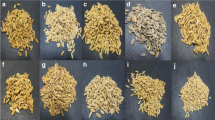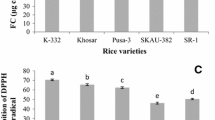Abstract
Aromatic rice contributes important group of rice due to its fragrance. These are rated best in quality and fetch higher price in global market. Joha rice is short-grained non-basmati aromatic rice known for its sweet-scented aroma and taste. Joha rice is still unexplored with scientific approach; therefore the present study has been designed to investigate the potentiality of 22 Joha rice varieties through proximate, physicochemical and antioxidant properties. Among all the rice landraces, maximum amount of amylose (19.33%) was obtained in Kon Joha, besides, highest water absorption index value (3.6 g/g). On the other hand, water soluble index was recorded in a range of 0.011–0.046 g/g in all the experimental aromatic rice landraces. Highest phenolic content was found in Kola Joha (54.11 mg) as compared to gallic acid equivalent (GAE)/100 g which also showed significantly higher antioxidant properties. The antioxidative capacity among Joha rice differ significantly with a range of 12.90–18.49% for DPPH and H2O2 scavenging activity ranged from 23.12 to 52.33%. Findings of the study indicate that aromatic rice could be used as functional food ingredients as well as sources of natural physicochemical and antioxidant rich substance.
Similar content being viewed by others
References
AACC International (2000) Approved methods of analysis, 10th edn. 2. Method 44-15A, 46-19 and 61-02. AACC International, St. Paul
Abdel-Aal E-SM, Sosulski FW, Adel ASY, Youssef MM, Ibave JL (1992) Effect of extrusion cooking on the physical and functional properties of wheat, rice, and faba bean blends. LWT 25:21–25
Anderson RA (1976) Wild rice: nutritional review. Cereal Chem 53:949–955
Anon (2004) Ricecheck. Best management practice for ricegrowing. NSW DPI and RIRDC Rice Research and Development Commmittee,Yanco NSW
AOAC (1990) Official methods of analysis. Association of Official Analytical Chemists (AOAC), Washington, DC, pp 1–50
Asaduzzaman Haque E, Rahman J, Kamrulhasan SM, Ali MA, Akter S, Ahmed M (2013) Comparisons of physiochemical, total phenol, flavonoid content and functional properties in six cultivars of aromatic rice in Bangladesh. Afr J Food Sci 7(8):198–203
Beta T, Celli GB, Pereira-Netto AB (2011) Comparative analysis of total phenolic content, antioxidant activity and flavonoids profile of fruits from two varieties of Brazilian cherry (Eugenia uniflora L.) throughout the fruit development stages. Food Chem 44:2442–2451
Bhat R, Sridhar KR (2008) Nutritional quality evaluation of electron beam-irradiated lotus (Nelumbo nucifera) seeds. Food Chem 10:174–184
Bhonsle SJ (2010) Grain quality evaluation and organoleptic analysis of aromatic rice varieties of Goa, India. J Agric Sci 2(3):99–107
Bryant RJ, Kadan RS, Champagne ET, Vinyard BT, Boykin D (2001) Functional and digestive characteristics of extruded rice flour. Cereal Chem 78(2):131–137
Buresova I, Sedlackova I, Famera O, Lipavsky J (2010) Effect of growing conditions on starch and protein content in triticale grain and amylose content in starch. Plant Soil Environ 56:99–104
Chutia J, Borah SP, Tanti B (2012) Effect of drought stress on protein and proline metabolism in seven traditional rice (Oryza sativa Linn.) genotypes of Assam, India. J Res Biol 2(3):206–214
Das A, Tushar Kesari V, Rangan L (2010) Aromatic Joha rice of Assam—a review. Agric Rev 31(1):1–10
Dela-Cruz N, Khush GS (2000) Rice grain quality evaluation procedures. In: Singh RK, Singh US, Khush GS (eds) Aromatic rices. IBH publishing Co. Pvt. Ltd., Oxford, pp 15–28
Devi N, Padmavathi G, Ravindra V, Babu Waghray K (2015) Proximate nutritional evaluation of rice (Oryza sativa L.). J Rice Res 8(1):23–32
Ebrahimzadeh MA, Pourmorad F, Bekhradnia AR (2008) Iron chelating activity, phenol and flavonoid content of some medicinal plants from Iran. Afr J Biotechnol 7(18):3188–3192
Eram S, Singh AK, Singh A, Singh NK, Singh PK (2014) Physicochemical characterization and organoleptic analysis in rice cultivars. Ind J Agric Res 48(6):437–445
Heath RL, Packer L (1968) Photoperoxidation in isolated chloroplasts. I. Kinetics and stoichiometry of fatty acid peroxidation. Arch Biochem Biophys 125:189–198
Hoover R, Sosulski F (1986) Effect of cross linking on functional properties of legume starches. Starch Starke 5:149–155
Iqbal S, Bhanger MI, Anwar F (2005) Antioxidant properties and components of some commercially available varieties of rice bran in Pakistan. Food Chem 93:265–272
IRRI (2009) http://www.knowledgebank.irri.org/millingprocess/index.php/ricequality-mainmenu-281/quality-characteristics-of-milled-rice-mainmenu-283. Accessed 17 Nov
Jane J, Chen YY, Lee LF, McPherson AE, Wong KS, Radosavljevic M, Kasemsuwan T (1999) Effects of amylopectin branch chain length and amylose content on the gelatinization and pasting properties of starch. Cereal Chem 76:629–637
Juliano BO (1985) Criteria and test for rice grain qualities. In: Juliano BO (ed) Rice chemistry and technology, 2nd edn. American Association of Cereal Chemists, Paul, pp 17–57
Kadan RS, Bryant RJ, Millar JA (2008) Effects of milling on the functional properties of rice flour. J Food Sci 73(4):151–154
Kalita J, Pradhan AK, Shandilya ZM, Tanti B (2018) Arsenic stress responses and tolerance in rice: physiological, cellular and molecular approaches. Rice Sci 25(5):235–249
Lahkar L, Tanti B (2017) Study of morphological diversity of traditional aromatic rice landraces (Oryza sativa L.) collected from Assam, India. Ann Plant Sci 6(12):1855–1861
Lowry OH, Rosebrough NJ, Farr AL, Randall RJ (1951) Protein measurement with the folin phenol reagent. J Biol Chem 193:265–275
Mcdonald S (2001) Phenolic content and antioxidant activity of olive extracts. Food Chem 73:73–84
Montgomery DC (2005) Design and analysis of experiments, 6th edn. Wiley, Hoboken
Mpofu A, Sapirstein HD, Beta T (2006) Genotype and environmental variation in phenolic content, phenolic acid composition and antioxidant activity of hard spring wheat. J Agric Food Chem 54:1265–1270
Nahar S, Kalita J, Sahoo L, Tanti B (2016) Morphophysiological and molecular effects of drought stress in rice. Ann Plant Sci 5(9):1409–1416
Nahar S, Sahoo L, Tanti B (2018a) Screening of drought tolerant rice through morpho-physiological and biochemical approaches. Biocatal Agric Biotechnol 15:150–159
Nahar S, Vemireddy LR, Sahoo L, Tanti B (2018b) Antioxidant protection mechanisms reveal significant response in drought-induced oxidative stress in some traditional rice of Assam, India. Rice Sci 25(4):185–196
Nielsen SS (2002) Introduction to the chemical analysis of food. CBS Publisher and Distributor, New Delhi, p 256
Oko AO, Ubi BE, Efisue AA, Dambaba N (2012) Comparative analysis of the chemical nutrient composition of selected local and newly introduced rice varieties grown in Ebonyi State of Nigeria. Int J Agric For 2(2):16–23
Onyeike EN, Olungwe T, Uwakwe AA (1995) Effect of heat treatment and defatting on the proximate composition of some Nitrogen local soup thickers. Food Chem 53:173–175
Oyaizu M (1988) Antioxidaive activities of browning products of glucosamine fractionated by organic solvent and thin-layer chromatography. Nippon Shokuhin Kogyo Gakkaishi 35:771–775
Roy SJ, Baruah PS, Lahkar L, Gurung L, Saikia D, Tanti B (2019) Phytochemical analysis and antioxidant activities of Homalomena aromatic Schott. J Pharmacogn Phytochem 8(1):1379–1385
Ruch RJ, Cheng SJ, Klaunig JE (1989) Prevention of cytotoxicity and inhibition of intracellular communication by antioxidant catechins isolated from Chinese green tea. J Carcinogenis 10:1003–1008
Saikia S, Himjyoti D, Daizi S, Charu LM (2012) Quality characterization and estimation of phytochemical content capacity of aromatic pigmented and non pigmented rice varieties. Food Res Int 46:334–340
Samal KC, Rout GR, Das SR (2014) Study of genetic divergence of indigenous aromatic rice (Oryza sativa L.): potentials and consequences of on-farm management in traditional farming. Int J Agric Sci 4(4):176–189
Sarma B, Basumatary NR, Nahar S, Tanti B (2016) Effect of drought stress on morpho-physiological traits in some traditional rice cultivars of Kokrajhar district, Assam, India. Ann Plant Sci 5(8):1402–1408
Shah K, Kumar RG, Verma S, Dubey RS (2001) Effect of cadmium on lipid peroxidation, superoxide anion generation and activities of antioxidant enzymes in growing rice seedlings. Plant Sci 161(6):1135–1144
Shen Y, Jin L, Xiao P, Lu Y, Bao J (2009) Total phenolics, flavonoids, antioxidant capacity in rice grain and their relations to grain colour, size and weight. Cereal Sci 49(1):106–111
Singh SP, Mishra NC, Rir-Sima-Ah J, Campen M, Kurup V, Razani-Boroujerdi S (2009) Maternal exposure to second hand cigarette smoke primes the lung for induction of phosphodiesterase-4D5 isozyme and exacerbated Th2 responses: rolipram attenuates the airway hyperreactivity and muscarinic receptor expression but not lung inflammation and atopy. J Immunol 183(3):2115–2121
Sompong R, Siebenhandl-Ehn S, Linsberger-Martin G, Berghofer E (2011) Physicochemical and antioxidative properties of red and black rice varieties from Thailand, China and Sri Lanka. Food Chem 124:132–140
Soni PL, Sharma HW, Bisen SS, Srivastava HC, Gharia MMA (1987) Unique physico-chemical properties of sal (Shorea robusta) starch. Starch Stärke 39(12):411–413
Sood BG, Siddiq EA (1978) A rapid technique for scent determination in rice. Ind J Genet Plant Breed 38:268–271
Tester RF, Morrison WR (1990) Swelling and gelatinization of cereal starches. II. Waxy rice starches. Cereal Chem 67:558–563
Thomas R, Wan-Nadiah WA, Bhat R (2013) Physiochemical properties, proximate composition, and cooking qualities of locally grown and imported rice varieties marketed in Penang, Malaysia. Int Food Res J20(3):1345–1351
US Department of Agriculture (1989) Composition of foods—cereal grains and pasta. Agricultural handbook no. 8-12. U.S. Dept of Agric, Washington, DC
Verma DK, Srivastav PP (2017) Proximate composition, mineral content and fatty acids analyses of aromatic and non-aromatic Indian rice. Rice Sci 24(1):21–31
Wang HL, Swain EW, Hesseltine CW, Gumbmann MR (1978) Protein quality of wild rice. J Agric Food Chem 26(2):309–312
Webb BD (1985) Criteria of rice quality in the U.S. In: Juliano B (ed) Rice: chemistry and technology. Association of Cereal Chemistry Inc., St. Paul, p 774
Acknowledgements
Funding support received from Department of Biotechnology (DBT), Govt. of India for the research project entitled “Development of high yielding, non-lodging and biotic resistant varieties of black scented rice of Manipur and Joha rice of Assam through biotechnological intervention” vide sanction number DBT-NER/AGRI/29.2015, dt. 19/10/2016 is greatly acknowledged.
Author information
Authors and Affiliations
Corresponding author
Ethics declarations
Conflict of interest
The authors declare that there is no conflict of interest in the present study.
Additional information
Publisher's Note
Springer Nature remains neutral with regard to jurisdictional claims in published maps and institutional affiliations.
Rights and permissions
About this article
Cite this article
Lahkar, L., Hazarika, G. & Tanti, B. Proximate composition, physicochemical and antioxidant properties revealed the potentiality of traditional aromatic (Joha) rice as functional food. Vegetos 33, 40–51 (2020). https://doi.org/10.1007/s42535-019-00076-7
Received:
Revised:
Accepted:
Published:
Issue Date:
DOI: https://doi.org/10.1007/s42535-019-00076-7




